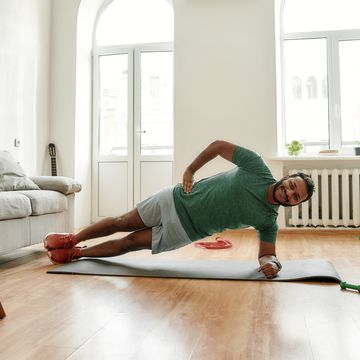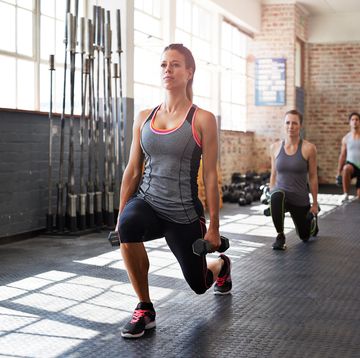Do you spend most of your day sitting at a desk or table? Then you've almost certainly got tight hip flexors. They can also be a common problem amongst those who drive or cycle a lot. Whatever the cause, having tight hip flexors can lead to problems when you run. After all, those flexors - the muscles that allow flexion at the hip joint – play a crucial role in moving your legs.
‘The iliopsoas is the strongest group of muscles in the hip flexors, connecting the spine to the femur, and it’s what helps contract and pull the thigh towards the torso, allowing you to bring your knee towards your chest as you run,’ says Amanda Nurse, an elite marathon runner, running coach and yoga instructor. When you run, you’re repeatedly shortening that muscle, and if you don't address this and release tight hip flexors, it can lead to imbalances.
Of course, this is not just a question of stretching but also of muscle weakness - if your hip flexors are too weak to work properly, then they will feel tight and need to be worked on and strengthed, not simply just stretched.
Regardless, sitting down all day at a computer or in a car seat will only exacerbate the problem. ‘The more time we spend sitting, the more the iliopsoas shortens,’ says Tom Holland, an exercise physiologist. ‘The shorter that muscle, the shorter your stride becomes – and that throws off your natural gait, which can create compensations that lead to injury in the muscles that work to move us forward and stabilise us as we run.’
That’s why it’s important, now more than ever, to give your tight hips some TLC. ‘Never before has strength training, stretching and mobility work been more important for runners,’ says Holland. ‘All day, we do the unnatural – sitting – and then we try to do the natural – running – and our bodies aren’t ready for it.’ Walking is good for the hip flexors, but to run far more efficiently (and, crucially, without pain), strategically opening and also strengthening your hip flexors needs to be part of your running routine.
How to strengthen your hip flexors
The Runners World Editors warm-up drills, says Holland. ‘Two to three minutes of high knees, bum kicks, skipping and running backwards will open up the hips in the front, side and back planes of motion,’ he explains. Holland also suggests doing strength work in different planes of motion to keep all the muscles in and around your hip flexors – especially your glutes – firing correctly.
‘You can’t have good hip flexion if your glutes are tight or weak,’ says Nurse, ‘so it’s very important that you’re always stretching and strengthening the front of your hip flexor and the back, which are the glute muscles.’ Unilateral exercises such as step-ups Advertisement - Continue Reading Below walking lunges, lateral lunges, air squats and jump squats Strengthens quads and hips, lengthens psoas.
Whether you are at the gym or heading out for (or coming back from) a run, these five moves will strengthen and release tight hips, keep them loose in the long term and not only make you a better runner, but also make running feel better.
How to release tight hips
1. Low-lunge variation
Start in a low lunge with your right foot planted, right knee bent and your left knee on the floor. Place your palms flat on each side of your right foot. Lift your left arm above your head as you lean to the right. Hold for five breaths, then repeat on the opposite side.
Strengthens glutes especially the glute medius and the hip flexors: Strengthens quads and hips, lengthens psoas.
2. Crescent lunge knee-up
Start in a high lunge, right foot forward, knee at 90 degrees, hips square and toes facing forward. Lift your arms as you stand and draw your left knee towards your chest. Return to start position. Do 10 reps, repeat on the left leg.
Strengthens glutes especially the glute medius and the hip flexors: Strengthens glutes (especially the glute medius) and the hip flexors.
3. One-legged bridge lift and lower
Lie face up, knees bent. Lift your arms. Engage glutes to lift hips. Transfer weight to your right leg and extend your left leg for five breaths. Lower your leg, hover over the floor for five breaths, then lift back up. Do eight reps, then repeat on the left leg.
Strengthens glutes especially the glute medius and the hip flexors: Activates the glutes, and strengthens the hip flexors.
4. Skating squat
Stand with legs just wider than hip-width apart. Lower into a squat. Shift your weight to your right leg as you rise up to standing and extend your left leg back, like you’re on skates. Return to a squat and repeat on the opposite leg. Alternate for 60 seconds.
Strengthens glutes especially the glute medius and the hip flexors: reasons why you should be deadlifting.
5. Full-range figure four
Sit upright with your knees bent, hands on the floor behind you. Cross your left ankle over your right knee. Let the left knee travel left, then back to the centre. Slowly go through the range of motion, then hold for five breaths for good hip stretches. Repeat on the other leg.
Strengthens glutes especially the glute medius and the hip flexors: Releases hip joints and stretches the glutes.


















